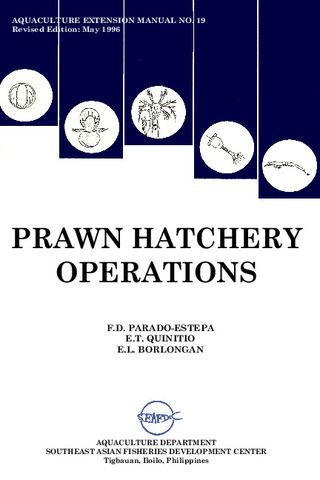Studies on the artificial insemination and fertilization of grass shrimp, Penaeus monodon
- Global styles
- MLA
- Vancouver
- Elsevier - Harvard
- APA
- Help

Date
1985Page views
3,397ASFA keyword
AGROVOC keyword
Taxonomic term
Metadata
Perlihat publikasi penuhShare
Abstract
The culture of grass shrimp, Penaeus monodon has become a fast-growing enterprise in Taiwan since formulated shrimp feed was successfully developed in 1978. In 1983, the total postlarval production for stocking reached 600 million at the price of 12.5 U.S. cents each. This high price of the postlarvae resulted from (1) limited availability of wild gravid females, (2) undesirable spawnings obtained by using the method of eyestalk ablation, manifested by a low average hatching rate of 20%, and (3) high demand from grow-out farms. The eyestalk ablated females induced to spawn were often found unmated which partly explained the poor spawnings and low hatching rates. Consequently, re-use of ablated females was not practised by farmers in the past.
The present paper describes the results of artificial insemination and fertilization of wild or pond-reared females whose gonadal development was induced by eyestalk ablation. The hatching rates from unmated soft-thelycum females implanted with two spermatophores are 84.7% and 43.7% while those implanted with only one spermatophore, 74.1% and 16.8%, for the first and subsequent spawning, respectively. These results positively confirm that the unmated condition of ablated females is the main reason for low hatching. Through artificial insemination, the spawning and hatching can be improved and ablated females can be re-utilized. For unmated hard-thelycum females, artificial fertilization was done by releasing spermatozoa into the spawning tank right before spawning. Out of 15 attempts, three were successful with hatching rates of 63.1, 52.3, and 49.9%.
Induced maturation of pond-reared shrimps was attempted by manipulation of temperature and salinity. Under constant temperature of 22±2°C, salinities ranging between 25 and 37 ppt were experimented. The best results with 67% success were obtained at salinities of 30 and 35 ppt. Continued efforts will be made to improve spawning performance through the technique of artificial insemination under controlled conditions.
Description
Abstract only.
Suggested Citation
Lin, M.-N., & Ting, Y.-Y. (1985). Studies on the artificial insemination and fertilization of grass shrimp, Penaeus monodon (Abstract only). In Taki Y., Primavera J.H. and Llobrera J.A. (Eds.). Proceedings of the First International Conference on the Culture of Penaeid Prawns/Shrimps, 4-7 December 1984, Iloilo City, Philippines (p. 167). Iloilo City, Philippines: Aquaculture Department, Southeast Asian Fisheries Development Center.
Type
Oral presentationISBN
9718511008
Related items
Showing items related by title, author, creator and subject.
-
An overview of the nutrition, feed and feeding techniques of prawn penaeid/shrimps
Piedad-Pascual, Felicitas (Philippine Council for Aquatic and Marine Research and Development, 1989)This paper echoes what transpired during the first International Conference of Penaeid Prawns/Shrimps held in Iloilo City in December 4-7, 1984, particularly on the Nutrition nd Feed Development. Around 25 papers were ... -
Series: Aquaculture extension manual; No. 19
Prawn hatchery operations
Parado-Estepa, Fe D.; Quinitio, Emilia T. ; Borlongan, Emeterio L. (Aquaculture Department, Southeast Asian Fisheries Development Center, 1996-05)
The manual, an updated version of the 1984 SEAFDEC/AQD manual, presents the underlying principles and step-by-step instructions of prawn larval and post-larval rearing. The techniques described are not only applicable to ...
; Borlongan, Emeterio L. (Aquaculture Department, Southeast Asian Fisheries Development Center, 1996-05)
The manual, an updated version of the 1984 SEAFDEC/AQD manual, presents the underlying principles and step-by-step instructions of prawn larval and post-larval rearing. The techniques described are not only applicable to ... -
The lowdown on world shrimp culture - II
Yap, Wilfredo G. (INFOFISH, 2001)This paper introduces some new members of the international shrimp culture club and goes on to discuss some recent technological innovations in the industry, particularly the polyculture of tilapia (mainly Oreochromis ...






